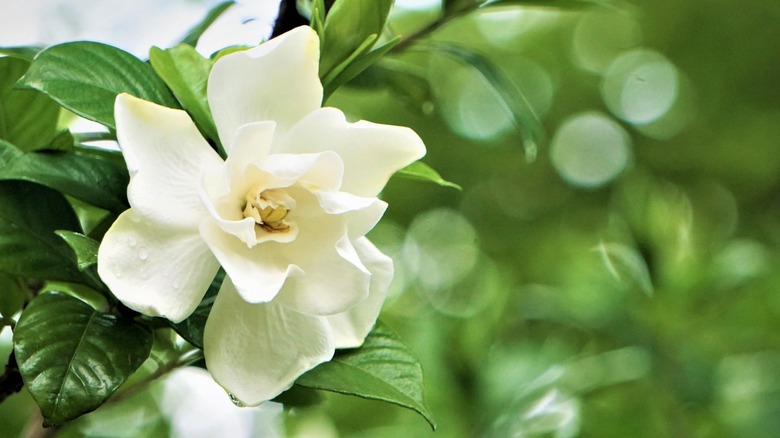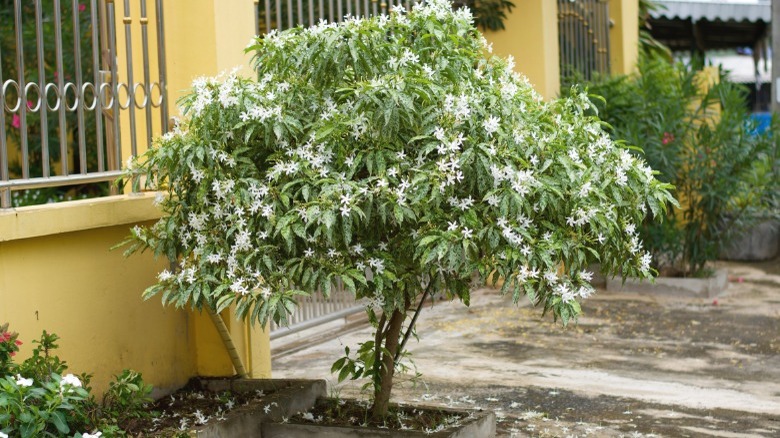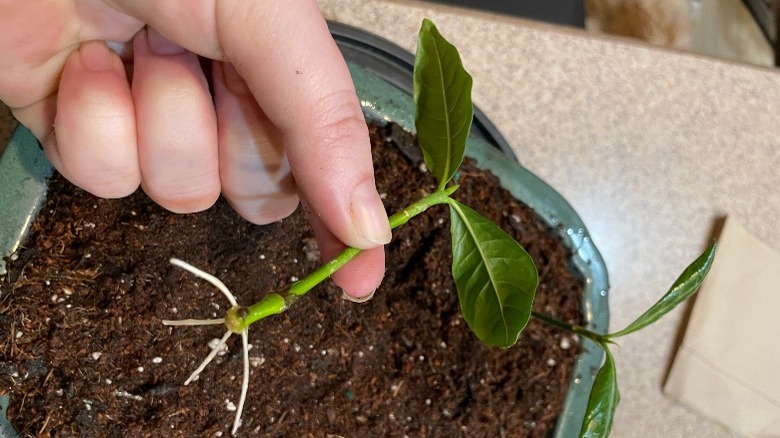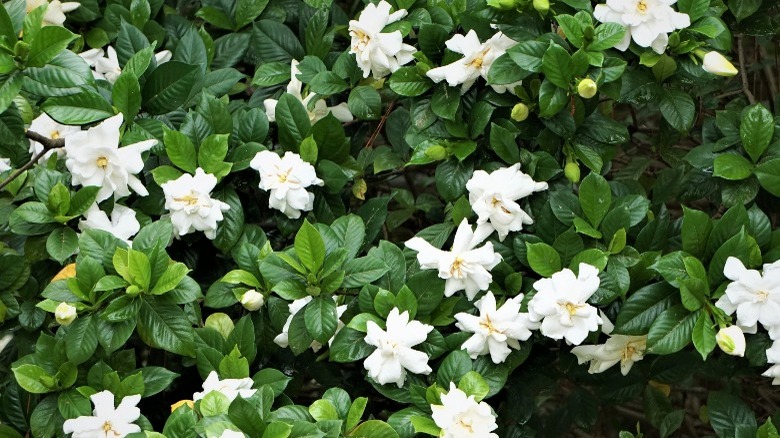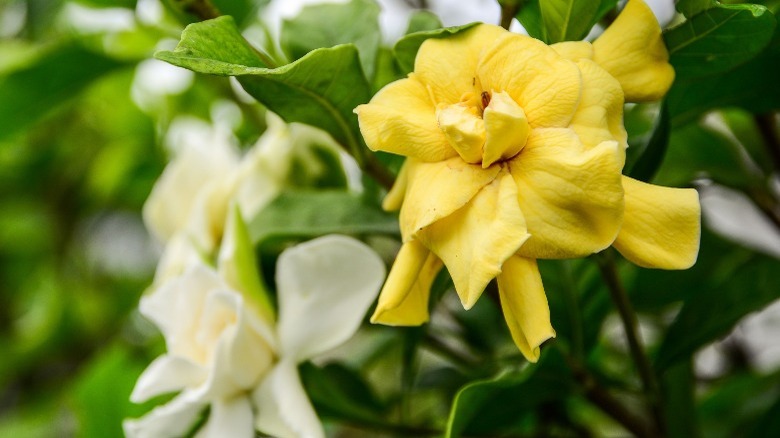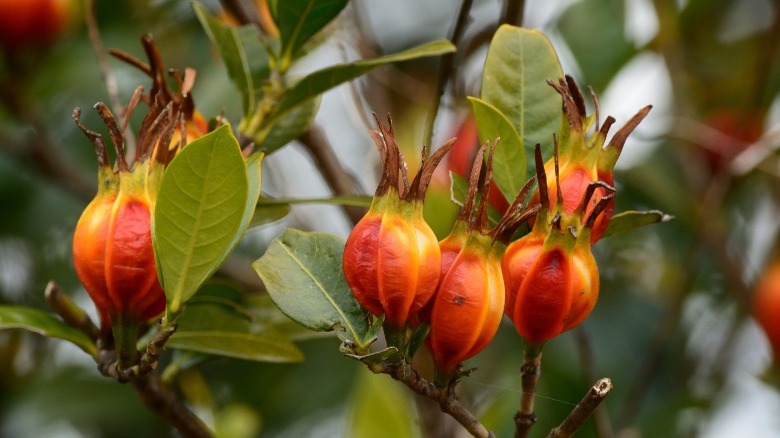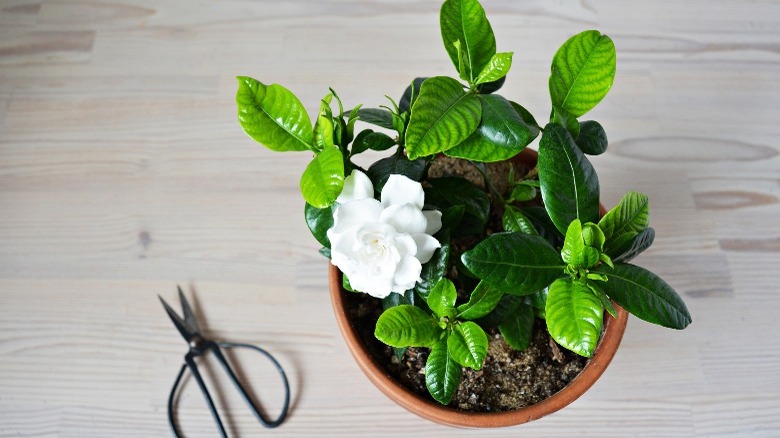How To Grow And Take Care Of Gardenias
The gardenia is a flowering evergreen perennial plant native to tropical and subtropical regions of Asia and Africa. Against glossy emerald leaves emerge large, whorled flowers that range from snow white to sun-kissed gold. Almanac explains that they vary rather drastically in size, from foot-tall dwarf varieties to others that can reach up to 8 feet tall, and spread just as wide. With so many options, you're sure to find the gardenia that will fit your perfect garden vision. Gardenia is prized primarily for its bold, complex fragrance — difficult to capture in words, but it can be described as piquant, creamy, and sweetly vegetal.
If you live in USDA zones 8 through 11, you'll be able to grow gardenias outdoors, but in regions outside of the plant's preferred range the outdoor climate is too cold for them to survive. Fortunately, gardenias can also be cultivated indoors in containers, though they will require slightly different and more frequent care, according to Gardening Know How. Though not the easiest plant to grow or care for, the gardenia's beauty and fragrance make it well worth the effort. Intimidating to many, it could be the perfect fit for anyone looking for a new gardening challenge, greater learning experience, and the personal satisfaction that will come with success. Read on to discover more about gardenias and decide if you're up to the challenge!
How to use gardenias in garden
Gardenias are one of the more versatile plants you can add to your garden. They can easily be incorporated into your existing garden landscape, or set apart as a showcase plant to celebrate their elegant flowers and lovely fragrance. Cultivation over centuries has drastically increased their diversity, but most gardenias grow to a manageable 3 to 6 feet in diameter, according to Gardener's Path. The shrub-like forms can be pruned into neat shapes or small trees, or allowed to grow wild for a more natural look. They are also tall enough that they can be planted in a row to form hedges along fences, paths, or anywhere else in order to create a greater degree of privacy. There are also dwarf varieties that grow lower to the ground, which can be used for ground cover or lower borders such as lining a garden bed.
Gardenias are well-known for their flowery scent, and tend to be most fragrant around the time the sun sets. Pollinators such as bees and butterflies are also attracted to gardenias, and their presence will benefit the other plants growing in your garden. After dusk falls, the white flowers appear luminous in the moonlight and attract pollinating moths as well, according to SFGate. You can also plant gardenias in containers to be grown either indoors or outside. Place them out of direct sunlight, such as around entryways where they can also be enjoyed by neighbors and other visitors.
How to grow gardenias
Gardenias can be grown from seed, but they can be difficult to germinate and the plant will not produce flowers for at least two or three years from planting. You'll have more success selecting a healthy nursery plant and transplanting it to your garden or a container in the fall. Be thoughtful about where to plant, as your gardenia will need plenty of room and shouldn't be uprooted once settled in its new home. Den Garden explains that gardenias require well-draining, acidic soil with a pH between 5.0 and 6.5. You can conduct an at-home test if you're unsure about the pH level in your soil, and add acidifying soil amendments if the results indicate the existing soil pH is too high.
The best way to propagate any gardenia plant is by planting stem cuttings directly in the soil. The Spruce advises that early spring is the ideal time for propagation. First, you'll need to prepare soil in a small pot to transplant to. Potting soil or starter soil is recommended to encourage new growth. When you're ready, select a green stem on your gardenia plant at least 3 to 4 inches long, and use sharp shears to cut right below a node. Plant the cutting deep enough that the bottom node is covered with soil. Finally, water the new plant and keep the soil relatively moist until roots form and the cutting can be transplanted to a larger pot or more permanent location.
How to care for gardenias
Gardenias aren't the easiest plant to grow and care for, but for the diligent and determined gardener, the result should be well worth the effort. With gardenias, consistency is key above all else. You'll need to water frequently to keep the soil moist without letting it dry out between waterings, but be careful not to overwater either. Outdoors, gardenias should be placed where they can receive morning sunlight but are shielded from the most intense afternoon rays, per Almanac. It can be more difficult to recreate indoors the conditions in which gardenias grow native, but if they receive bright indirect light and high humidity they should thrive. Gardenias living outdoors only require fertilizer once around mid-spring and a second dose in mid-summer. Indoor gardenias, by contrast, should be dosed monthly from April until November. For best results, use fertilizer specifically formulated for container plants that require acidic conditions.
Gardenias tend to fall victim to various disease and pests, as Gardener's Path laments. Gardeners should keep an eye out for aphids, whiteflies, and spider mites, and keep extermination options such as neem oil on-hand. Gardenias are also susceptible to developing fungal diseases such as sooty mold powdery mildew. You can use fungicides to treat the problem, but unfortunately infected plants cannot always be saved. The best method is preventative care, such as deadheading and pruning regularly, avoiding crowding by other plants, and maintaining appropriate humidity without allowing excessive moisture where disease can develop.
Varieties of gardenias
Gardenias prefer warm weather, and will thrive in climates most similar to their native Africa, South Asia, and Oceania, according to Gardenia. Originating from these regions and later cultivated around the world, there are now over 200 varieties of gardenia plants. That can be an intimidating number to choose from when planning your garden, but luckily you can narrow your search down to some of the most popular options:
- Gardenia jasminoides "Buttons" is the adorable name for the equally adorable dwarf variety of gardenia. Its delicate petals surround a yellow button-like center to form 2 inch flowers that bloom from May to June.
- Gardenia jasminoides "Frostproof" is known for its small double flowers and its ability to weather colder temperatures better than other varieties.
- Gardenia jasminoides "Pinwheel" is named for the narrow petals that form whimsical pinwheel-shaped flowers. It can get large and grows relatively quickly, so take care when choosing a location for this plant.
- Gardenia jasminoides "Veitchii" is an older variety with elegant double flowers and a longer blooming season that stretches from the beginning of spring to the end of the summer. It forms a dense bush that can reach 3 or 4 feet tall, making it a good choice for containers.
- Gardenia jasminoides "Golden Magic" undoubtedly stands out among other varieties for its unique yellow color. The petals start out cream colored but deepen to a rich gold as the double flower matures.
Are gardenias toxic?
According to the ASPCA, gardenias are considered mildly toxic to cats, dogs, and horses. If you suspect your pet may have ingested any part of a gardenia plant, you should call the APCC (Animal Poison Control Center) and your local vet as soon as you are able. Symptoms to look out for include mild vomiting, gastrointestinal issues, and hives, but gardenias have a minimal toxicity and are unlikely to result in death.
Thankfully, gardenias are not considered toxic to humans. Certain plants can cause skin irritation, so it is best to wear gloves when gardening to protect yourself. In fact, the flower petals are edible and are said to have a slightly sweet flavor, great for making tea or infusing into baked goods.
In addition to beautiful flowers, gardenias also produce fruit. The red-orange berries emerge in the fall after the blooming season has ended. The berries are edible, but bitter, so they are typically used for medicinal rather than culinary purposes. According to WebMD, gardenia has traditionally been used in herbal medicine practices to treat ailments such as inflammation and liver disease, though the effectiveness of such treatments is yet to be extensively researched and confirmed. Historically, the berries were also widely used for their yellow pigment to dye food and textiles.
How to repot gardenias
Since gardenias are often grown in containers, knowing how and when to repot is very useful and necessary for ensuring the long-term health of your plant. If the health of your gardenia starts to decline and you can't otherwise determine the cause, it's likely time for repotting, The Spruce explains. Based on their average growth rate, you'll likely need to repot your gardenia every other year, if not every year. The best time to do so is in the early spring, before the plant begins to flower. Gardenias produce more flowers when slightly pot-bound, so take care not to repot too early or you might miss out on their deliciously fragrant blooms.
To start, you'll need low-pH potting soil and a pot with drainage holes, a few inches larger than the existing container. Classic terracotta is a good choice to help prevent the soil from retaining too much water, which can lead to root rot. First, line the bottom and sides of the new pot with fresh potting soil. Carefully remove your gardenia from its existing container, and gently brush away any loose soil still clinging to the roots. Center the plant in its new pot, and add soil until the root ball is completely covered. Water thoroughly to help the plant adjust, and place in a location with bright indirect light and adequate humidity to closely mimic its native tropical habitat. Soon your plant will flower and add beauty and elegance to your indoor space.
